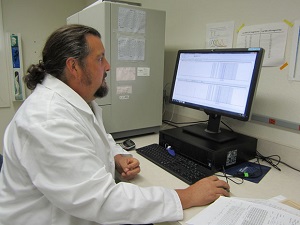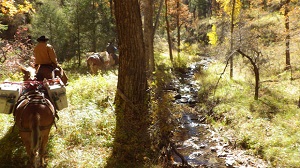 Craig Springer tells how a trout that once stared at extinction offers wilderness angling opportunities. The trout stole its color from a southern New Mexico summer sunset. Gila trout sport a painter’s pallet of pink and olive, rose, yellow and copper and a few tones in between. Beneath the black pepper flakes that fleck its side lies a lexis—a language carried forward from another time. It’s an ancient language coded in molecules of proteins written by the press of time and experience in a land turned arid.
Craig Springer tells how a trout that once stared at extinction offers wilderness angling opportunities. The trout stole its color from a southern New Mexico summer sunset. Gila trout sport a painter’s pallet of pink and olive, rose, yellow and copper and a few tones in between. Beneath the black pepper flakes that fleck its side lies a lexis—a language carried forward from another time. It’s an ancient language coded in molecules of proteins written by the press of time and experience in a land turned arid.
Gila trout, native only to headwater streams that vein over the Mogollon Rim of New Mexico and Arizona, have expressed in their genetic makeup a mapping of how to survive in the vestiges of what surely was a large and contiguous range. Their genetics equip them to face what nature may hurl at them in an already harsh environment.
It’s those innate characteristics coiled in the double-helix of DNA that Service biologists strive to preserve in the fish. Conservation genetics is at its heart an investment in the future with an eye on the past. Dr. Wade Wilson with the Service’s Southwestern Native Aquatic Resources and Recovery Center in Dexter, New Mexico, knows Gila trout like few others can; he’s a geneticist who can de-code the language. It’s his charge in the conservation of Gila trout to help ensure that the diversity of genetic characters unique in this fish stay in the fish going forward.
 |
| Dr. Wade Wilson works to keep Gila trout “wild.” Photo by USFWS |
Wilson works with another Service facility in New Mexico, the Mora National Fish Hatchery near Las Vegas, New Mexico, where captive stocks of the rare yellow trout are held. Hatchery biologists are fully immersed in Gila trout captive breeding, and it’s done smartly, carefully, through the consult of Wilson.
“We monitor genetic diversity in captive trout to ensure that what we have in the hatchery represents what we have in the wild,” says Wilson. That mixture is essential for the future. “The more genetic diversity that exists among the fish, the better chance those future generations of Gila trout can adapt to changing environments and stressors and diseases in wild populations,” Wilson adds.
“Here’s how we get it done,” explains an enthusiastic Nate Wiese, Mora’s manager and lead fisheries scientist. “Each fish gets a microchip injected just under the skin just like your vet can do for your dog. That chip gives each fish a personal ID, like a social security number. Knowing each fish at an individual level is a first step in securing the future of Gila trout.”
With every captive fish in the hatchery marked as such, biologists take non-lethal tissue samples from the fish, a tiny piece of fin. From there it’s up to Wilson and his staff using leading-edge technology to look deep at each fish—at the molecular level. Wilson will pinpoint individual fishes with the rarest of genetics in the captive populations and suggest what Wiese calls “pair-wise spawns.” It’s akin to arranged marriages but with the express scientific purpose to ensure that the rarest of genetic characters found by Wilson are carried forward in the next generation of fishes. Males and females that differ among various genes make the best partners.
The Gila trout was described by science a mere 65 years ago. Through much of that intervening time—50 years—it had been closed by law to angling as the fish stared at extinction. Its lot improved with conservation and was down-listed from “endangered” to “threatened” in 2006, and opened to fishing a year later. And so it remains, threatened and fishable, despite a welter of catastrophic wild fires—the sort that makes the evening network news broadcast for days on end.
“An integral part of the conservation strategy calls to replicate in the wild the distinct genetic lineages,” says Wiese. It’s a measure of conservation security to give a geographic spread between populations. “But what happens when a massive fire threatens to gobble up the original and replicate populations? The hatchery is the backup.”
Fire is hard on trout, particularly when a mountain stream turns into a slug of ash slurry at first rain post-fire. The Whitewater-Baldy Fire that decimated the Gila Wilderness in 2012 necessitated a trout rescue ahead of such circumstances. New Mexico Fish and Wildlife Conservation Office biologist Dustin Myers based in Albuquerque led such rescues involving pack horses and helicopters and hatchery trucks from streams sure to be slugged by ash. Now, Mora National Fish Hatchery is home to the only known population of the Spruce Creek lineage of Gila trout. Three other strains are held there, too: Main Diamond Creek, Whiskey Creek and South Diamond Creek lineages.
Aside from the robust genetics plans that steer captive breeding, Wiese manages the hatchery to produce Gila trout conditioned toward a wild environment. Instead of growing lazy trout as fat as toads, they are in a captive environment that mimics nature—like boulders, plants and fast-flowing water. “We get them off the couch and on a treadmill,” says Wiese. “They are going to be better suited for real streams. It’s like tough-love for your children.”
Those real streams are still healing from the 2012 fire and the Silver Fire that scorched headwaters atop the Black Range in 2013, and fish will return to them this autumn. Myers makes that call as to what streams are ready for trout. “Since the Whitewater-Baldy Fire we’ve replicated Whiskey Creek lineage in McKenna Creek and Upper White Creek,” says Myers. “Whiskey fish will also go into Sacaton Creek this year. But Whiskey Creek itself is still healing and we have to wait for habitat conditions to improve.”
 |
| Returning Gila trout to the wild often involves four-legged transportation. Photo by USFWS |
It’s about the habitat—including ensuring that Gila trout waters remain free of mongrel or nonnative trouts that compromise the genetic integrity of pure lineages via interbreeding. Barriers, made on site, or natural waterfalls are a means of segregating fishes. Toward that end, Myers recently worked with the Forest Service to restore a vital barrier, a natural waterfall, by blasting out lodged boulders to ensure 21 miles of prime Gila trout habitat in the West Fork Gila remain free of unwanted fishes.
The lack of habitat vexes Gila trout conservation. But science married with the resolve of individuals who care about this beautiful bright trout is a way forward. A certain splendor in the spectra of inspiring pigments reflected by a wet Gila trout call to mind Emerson: “If eyes were made for seeing, then beauty is its own excuse for being.” But the beauty is richer than what strikes the eye; it’s that Gila trout sheltered in a hatchery and those facing the rigors of the wild still carry today the impress of the past.
Craig Springer works for the Service in Albuquerque.
